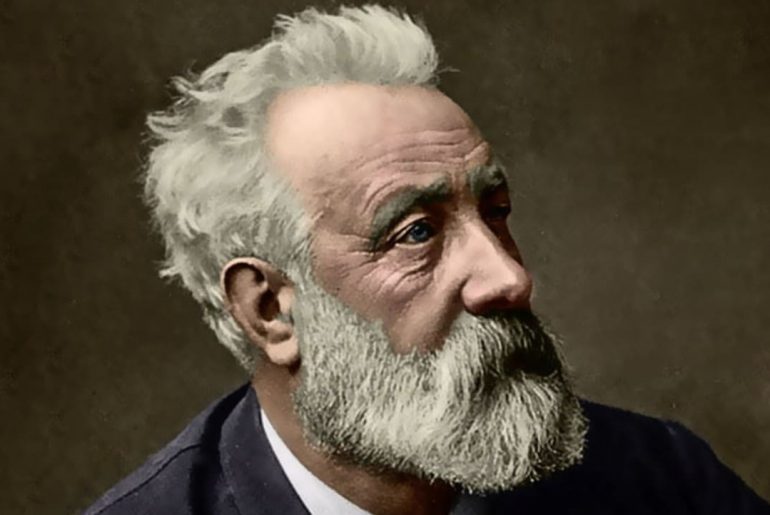The French writer became world famous with his literary science fiction and science fiction novels as the founder of this genre. His fantastic works, such as “Journey to the Center of the Earth” (1864), “From the Earth to the Moon” (1965), “20,000 Leagues Under the Seas” (1870) or “Around the World in 80 Days” (1873 ) are based on precise research into technically possible devices, which characterize the author as both a dreamer and a visionary scientist. Jules Verne anticipated many technical conquests in his books of his time. However, he considered himself an author of “scientifically instructive novels”, as he called them: the attentive reader is informed about the fauna, flora, geography and history of the traveled areas. Sometimes entire chapters are purely informative excursions…
Jules-Gabriel Verne was born in Nantes, France, on February 8, 1828, the son of a lawyer.
Even as a child, Jules Verne is said to have indulged in daydreams. After graduating from school, he began studying law in Nantes, in accordance with his father’s wishes. In 1848 he moved to the University of Paris. Literature and theater attracted his attention even more than his studies. Verne joined literary circles and made the acquaintance of Alexandre Dumas. The young law student devoted himself to writing dramas. However, together with Dumas he also created operas and libretti. On June 12, 1850, Verne’s first work premiered at the Paris Théatre Historique. Two years later he found a job at the Théatre Lyrique as a secretary, which he held until 1855. The following year he became a stockbroker. In the off-hours he continued to devote himself to writing. In 1857 Verne married the widow Honorine Morel, née Deviane, of Amiens. She brought two daughters into the connection, from which their son Michel came in 1861. To earn a living, Verne continued to work on the stock exchange and in the theatre.
On various trips he collected scientific notes, which also found their way into his works. He joined a society for the promotion of airships and worked on projects for hot air balloons. Vernes’ novel “Five Weeks in a Balloon” was published in 1863, inspired by a friend’s balloon accident. The work became a great success for the writer, who established his literary fame with it, and the publisher signed the author. This employment secured him a certain standard of living. Some of his adventure novels were published in the publishing journal “Belehrung und Freizeit”. They were later published as a series entitled “Voyages Extraordinaires”. In 1864 the title “Journey to the Center of the Earth” was published, which caused a sensation due to its fantastic unimaginability. The following year, Verne anticipated the journey to the moon in his book “From the Earth to the Moon”. Verne’s literary activities also include geographical works. He was interested in a wide range of subjects such as chemistry, zoology, geography, physics and technology.
He obtained information from contemporary media, which he created in a file of over 20,000 notes. In 1871 Verne settled in Amiens with his family. There he headed the Académie d’Amiens. Other extremely successful future and adventure novels followed, such as “Around the World in 80 Days” (1873), “The Mysterious Island” (1874/75) and “Mathias Sandorf” (1885). Verne was now considered a renowned novelist, and financial success came with his reputation. He continued to travel extensively. To do this, he acquired an ocean-going yacht. In Amiens he became a councilor. As an author he was honored several times and received an audience with the Pope in Rome. In his works he anticipated many technical achievements for which not even the basics had been realized at the time. In his literary ideas he not only created airships, nuclear submarines and helicopters, but also steel cities and propeller islands. He thus represented a contemporary belief in progress oriented towards emerging technology, which, however, pointed far ahead in a remarkable way.
Verne is thus regarded as a pioneer of modern science fiction literature. In later works, his technical optimism was tempered by doubts about the misuse of technology. He was right about that too. Despite all the fame, he was also troubled by envious people, lawsuits and an assassination attempt. In 1900 he moved within Amiens. Verne suffered from diabetes in old age, and his health quickly deteriorated. Many of Verne’s books were later extensively filmed by Hollywood. The fabric was made for the American dream factory.
Jules Verne died in Amiens on March 24, 1905.
What is Jules Verne famous for?
Jules Verne was a prolific writer. He is often referred to as the “father of science fiction.” Verne became famous for his Voyages Extraordinaires, a series of 54 novels that were originally published by the French publisher and author Pierre-Jules Hetzel.
Was Jules Verne scientifically accurate?
Although his methods were certainly not scientifically accurate, Verne’s imagination was over a hundred years ahead of one of the most important feats in history: the arrival of the first humans to the moon.
Who was Jules Verne for kids?
The French author Jules Verne is known as one of the first science fiction writers. He wrote more than 50 novels and many short stories. Verne was born on February 8, 1828, in Nantes, France. He studied law and worked for a while as a stockbroker.
Why is Jules Verne considered the father of modern science fiction?
Jules Verne is considered the father of modern day science-fiction because; he was an ameteur astronomer and scientist, his fanciful inventions were created, and he influenced the world with his novels. Voyages Extraordinaires was comprised of more than sixty novels, most of which referred to astronomy and science.





